You’ve built an email list and have started sending out campaigns to promote your brand. But if you haven’t started using email A/B testing, you’re missing a golden opportunity to optimize your campaigns and boost your results.
Email A/B testing, also known as split testing, is a powerful strategy that allows you to compare 2 different versions of your emails to see which one performs better.
Here at OptinMonster, our email marketing list includes over 235,000 subscribers. To keep those subscribers engaged, we regularly split test our email campaigns to optimize them for higher open rates, click rates, and conversions.
In this guide, I’ll share everything you need to know to get started with email split testing. I’ll discuss the benefits of A/B testing email campaigns, what elements you should test, and best practices. Plus, I’ll explain the steps for running email A/B tests with 3 different popular email marketing platforms.
- What Is Email Split Testing?
- Why Do You Need to A/B Test Email Campaigns?
- What Email Elements Can You Split Test?
- 8 Best Practices for Email Split Tests
- How to Run an Email Marketing A/B Test (3 Tools)
- Grow Your Email List by Split Testing Your Optin Forms
What Is Email Split Testing?
Before we get into how to split test email campaigns, let’s understand what email split testing is.
Email split testing means testing the original version of your email (the control) against another version (the variation, or variant) where you have changed a single element, like an email subject line, a call to action (CTA) button, or a part of the design.
As we said, split testing means changing just one element. If you want to change more than one element on your email, then that’s multivariate email testing. Multivariate testing lets you compare multiple versions of an email at once, instead of just 2. It’s a much more advanced technique that requires a very large email list and sample size, as well as more technical expertise.
For this article, I’ll focus on A/B split tests, which compare 2 versions of an email with 1 element changed.
Why Do You Need to A/B Test Email Campaigns?
When you split test email campaigns, it can help you:
- Base decisions about your email marketing campaigns on data rather than gut instinct or guesswork.
- Know when email marketing campaigns are working and when they are not, based on customers’ actual responses to actual campaigns.
- Create more effective email marketing campaigns based on the insights you gain, resulting in more engagement, leads, and sales.
- Get more people to open your emails, click your links, and ultimately convert.
- Minimize the risk of making major changes by testing them first.
For all these reasons, email split testing has to be an essential part of your marketing strategy.
What Email Elements Can You Split Test?
You can A/B test practically any element of an email campaign, from subject line to button color to copywriting. However, there are 2 important caveats:
- You should only test 1 element at a time
- Different email marketing platforms have different A/B testing functionality. I’ll talk about that more later.
Here are the most common email elements that you should consider for A/B testing.
1. Email Subject Lines
Subject lines are by far the most common email element to split test. Some email marketing platforms, such as Constant Contact, only offer built-in A/B testing for subject lines. Subject line tests focus on improving your email open rates since convincing subscribers to open is the primary goal of your subject lines.
Here are a few tactics you might try out in a subject line split test:
- Subject line length: Compare the performance of a shorter vs. longer subject line.
- Emojis: Test whether to use an emoji or test between 2 different emoji options.
- Personalization: Try adding your subscribers’ names through a personalization tag.
- Humor: See if a funny subject line gets more opens than a serious one.
- Mystery vs. Detail: How much detail should you give in your subject line? For instance, should you say “Biggest Sale of the Year” or “40% Off Everything”?
We regularly A/B test our subject lines here at OptinMonster, where have an email newsletter all about digital marketing. Earlier this year, we sent an email that discussed how to avoid bad-faith SEO tactics:
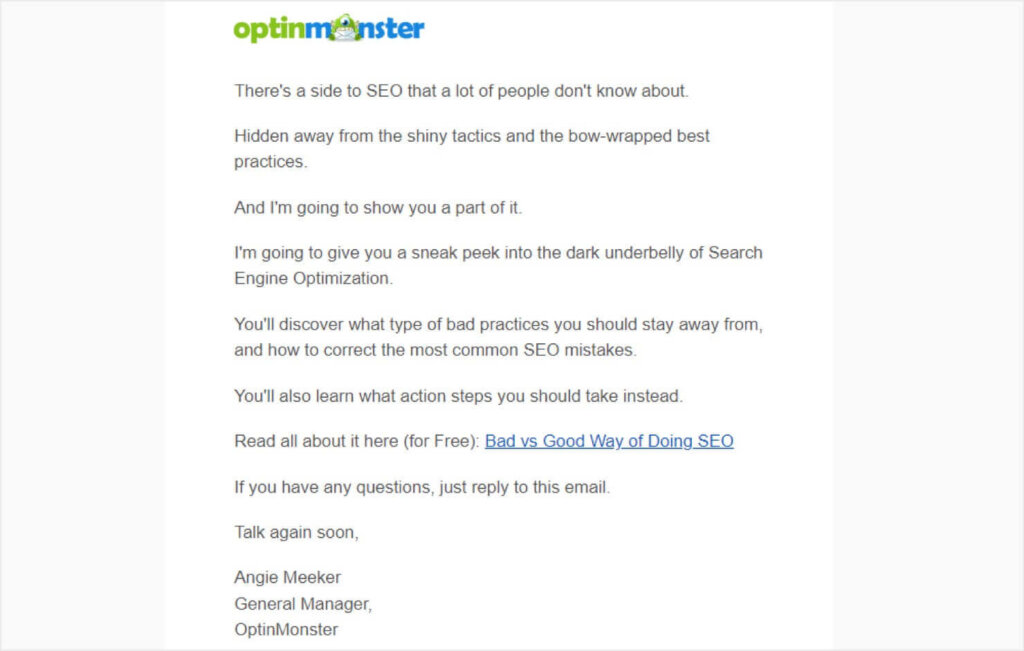
Before sending the email out to our full subscriber list, we ran a split test with 2 different subject lines:
- Version 1: The Dark Underbelly of SEO
- Version 2: Are you making these SEO mistakes?
Version 1 received a slightly higher open rate in the A/B test. Interestingly, Version 1 also had a significantly higher click-through rate (CTR). In other words, more people clicked the link inside the email and visited our website. In this case, the more mysterious subject line won the test and was sent out to our full list.
These results show the power of split testing your subject lines. When you nail your subject line, you not only get more opens, but you also set the tone for how readers will interact with your message.
2. Calls-to-Action (CTAs)
Every marketing email you send should focus on getting users to take a specific action. That action might be buying a product, reading a piece of content, registering for an event, using a coupon code, or following you on social media.
Your email’s call-to-action (CTA) is the button or linked text that users click to take an action. In the IPSY email below, the CTA is the Shop Now button, which leads to a product page for discounted lip products.

Optimizing your CTAs is vital to the success of your email marketing campaigns. Here are a few ways you can A/B test an email CTA:
- Placement: Where should your primary CTA be placed within your email?
- Size: Pinpoint the perfect button or font size.
- Number: Many emails show the same CTA more than once. You can test whether repeating it helps you get more clicks.
- Wording: Try different copy for your CTA. For instance, you could test “Get Started Today” vs. “Download Now.”
- Color: Discover which button color best draws the reader’s eye.
When running a CTA split test, you’ll monitor which variant gets more clicks, so you can send out a higher-converting campaign.
Learn More About Email Calls-to-Action:
3. Email Copy
For the body of the email, you can alter the wording of different parts of the content. For instance, you can run email A/B tests on:
- Headings: Test 2 variations of your email’s main heading
- Length of paragraph copy: How much explanation does your audience need to convince them to click your CTA?
- Tone and style: Experiment with tones in your email copy. For instance, you can test funny vs. serious, first-person vs. third-person, or formal vs. casual.
Here at OptinMonster, we’ve discovered that our audience responds best to a casual tone and first-person advice.
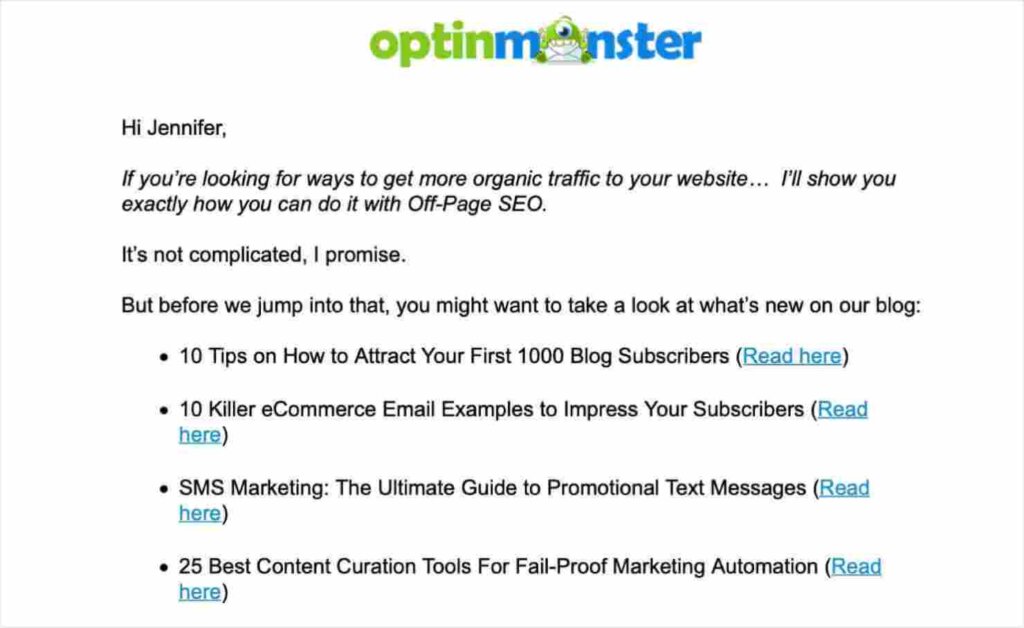
Over time, you’ll gain better insights into your audience based on how they respond to different copywriting techniques. For instance, you can try using urgency and the fear of missing out (FOMO) to make subscribers more interested in clicking.
4. Design and Layout
When you split test email campaigns, you can also try out different design and layout elements, such as:
- Templates: When designing an email newsletter, you can run email split tests to determine which template performs the best.
- Image Size & Placement: Determine how prominent your images should be in your emails.
- Color Schemes: Try out different color combinations for your text, background, and more.
- Animation & GIFs: See if adding an animated element increases subscriber engagement.
- Footer Designs: Your email footer contains many important links, such as social buttons. Run regular tests to see which design drives the most clicks on those links.
The look of your email is just as important as the words you write. Your email design sets the tone for your message and influences which elements capture your readers’ attention. Split testing allows you to optimize your design and improve engagement.
5. Sender Name (or From Name)
The subject line isn’t the only factor in your email open rates. In fact, according to one survey by Litmus, 42% of email recipients said they look at the sender name first when deciding whether to open an email.
Consider running email split tests to decide which sender name best catches your subscribers’ attention. The name of your company or brand is an obvious choice, but sometimes the name of a company representative can be more effective.
We’ve had great success using Angie at OptinMonster as our sender name. Angie is our General Manager, and using her name provides a personal touch to our campaigns. We still include “at OptinMonster,” so subscribers will recognize that the emails are part of our digital marketing newsletter.
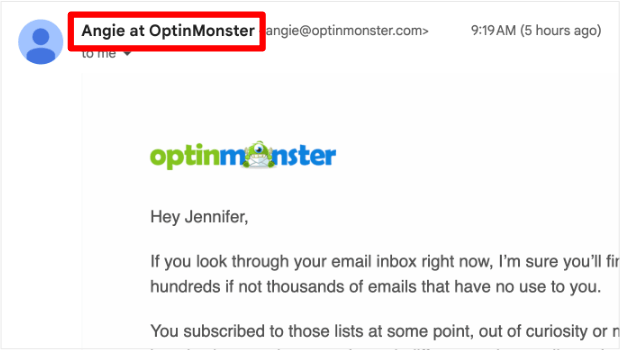
If your email marketing platform allows you to A/B test your sender name, I encourage you to give it a try. If it doesn’t, you can simply try out different sender names to see which one performs best. This technique won’t be quite as reliable as a true split test, but it can still help you optimize your email strategy.
6. Preview Text (or Preheader Text)
Email preview text is the extra copy that displays in an email inbox underneath the subject line:
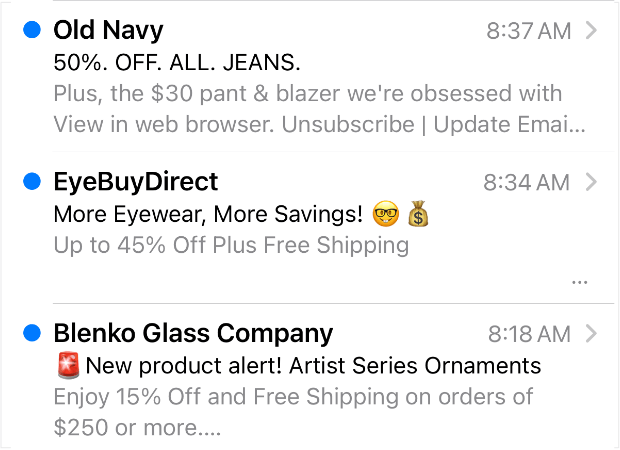
Preview text is the perfect place to add a bit more information about the contents of your email and to convince your subscribers to open.
Not all email marketing platforms let you split test the preview text, but if yours offers that functionality, use it! Preview text testing helps you pinpoint which information is most convincing to users.
8 Best Practices for Email Split Testing
Here are some A/B testing best practices to help you split test email campaigns successfully.
1. Set a Specific Goal for Your A/B Test
Before starting any email A/B test, it’s crucial to define clear objectives. Ask yourself what you hope to achieve with your test. Common goals include increasing open rates, improving click-through rates, or boosting revenue. Having a specific goal helps you measure success and stay focused on what matters most.
2. Know Your Audience
Understanding your audience is fundamental to successful A/B testing. In fact, it’s necessary for any marketing strategy. You should have a clear idea of your audience’s demographics and what they’re most interested in.
OptinMonster can help you better understand your subscribers from the get-go! When you build your email list with OptinMonster’s onsite campaigns, you can gather important information such as:
- The user’s geographic location
- Which lead magnet the user signed up for
- What content they were browsing
- Any other data you collect in an OptinMonster popup, floating bar, or other campaign
OptinMonster gives you a headstart on building a great email list and understanding what your subscribers are interested in.
3. Form a Hypothesis for Your Email Split Test
An A/B test is a type of experiment. And like all experiments, it must start with a hypothesis. A split testing hypothesis includes:
- Observing what’s happening currently
- Guessing about the possible reason
- Suggesting how you’re going to improve or fix the situation
- Measuring how you’ll know it has worked
Here’s how this could work:
- Observation: We noticed that our email click-through rate has declined over the last 6 emails we’ve sent.
- Possible reason: We believe it’s because we’ve been using the same CTA text in every email, and subscribers don’t notice it anymore.
- Suggested fix: We’re going to run an A/B split test. The control will have the current CTA text, and the variant will have different CTA text.
- Measurement: We’ll know our hypothesis is correct if the variant gets a higher open rate than the control.
For best results, create a hypothesis for every A/B test you run, so your testing strategy remains structured and relevant to your goals.
4. Split Test 1 Element at a Time
I’ve mentioned this best practice already, but it’s worth repeating: To determine which change impacts your email performance, test only 1 element at a time.
Here’s an example: You have a control email, and in your variant, you change the subject line, the main image, the headline, and the CTA text and color. You run your A/B test, and the variant performs better. However, you have no way of knowing which of the changes caused the improvement. Yes, you may get better results for that specific campaign, but you won’t learn anything to apply to future emails.
By isolating 1 variable, you can confidently attribute any differences in performance to that specific change.
5. Consider Statistical Significance
Statistical significance is a complicated topic, so I’ll just hit on the basics here. If you use too small of a sample size for your A/B test, your test results could be due to simple chance.
Let’s say you have a small email list of 350 subscribers. You send a subject line split test to 20% of your list, which is 70 addresses. Each version goes to 35 addresses. Version A sees an open rate of 25.7%, while Version B sees a 34.3% open rate.
It seems clear that Version B performed better. However, only 3 more people opened Version B than Version A. The percentage difference only looks significant because the sample size is so small.
If you have a similarly small email list, A/B testing can still help you gradually optimize your email marketing. You just need to understand the context of your testing and recognize that your results don’t provide hard proof of your audiences’ preferences.
Grow Your Email List & Run More Reliable Email A/B Tests!
Check out our guide: 17 Proven Tips To Get More Email Subscribers
6. Choose the Right Test Duration for Your Email A/B Test
Email marketing campaigns are much more time-sensitive than, say, designing a webpage. A/B tests for websites often run for days or weeks, but email split tests are sometimes as short as an hour or 2.
Here are some factors to consider when deciding how long to run the A/B test for an email marketing campaign:
- Email Frequency: How often do you send out email campaigns? If you send out weekly emails, your test could run for a couple of days. If you send out an email every day, then most of your tests will last a few hours.
- Subscriber Behavior: How quickly do your subscribers usually open and engage with your emails? Your split test should give enough time for your subscribers to engage in their usual behavior patterns.
- Focus Metric: If your A/B test focuses on open rates, your test can be shorter than if you’re measuring revenue earned from the email.
- Purpose & Importance of the Campaign: Let’s say you’re sending a particularly important email, like a new product announcement. You should build in more time to A/B test that campaign than you would for your regular email newsletter.
In short, the duration of your email split tests will vary depending on your goals, audience, and purpose.
7. Use Email Segmentation in Your Split Tests
Email segmentation is vital to sending more personalized and relevant messages to your subscribers. With segmentation, you don’t simply send every campaign to your entire list. Instead, you tailor your campaigns based on subscriber data such as purchase history, demographics, interests, and more.
Segmenting your email list before conducting A/B tests can provide more granular, specific insights. For instance, your new subscribers may respond differently than loyal customers who’ve purchased from you multiple times. When you run split tests for each segment, you’ll develop a strategy that works for all phases of your email marketing funnel.
8. Keep A/B Testing Your Email Campaigns
A/B testing is not a one-time activity. Continuously test different elements of your email campaigns to keep improving your results. As your audience’s preferences and behaviors change over time, ongoing testing ensures that your email strategy remains effective and up-to-date.
How to Run an Email Marketing A/B Test (3 Tools)
With a robust email marketing platform, you can set up A/B tests with just a few clicks. The software will handle sending out the test, monitoring the results, and then sending the winning variant to your full email list or segment.
However, each email software has different split testing functionality. I’m going to show you the basics of how A/B testing works on 3 popular email marketing platforms:
| Email Software | A/B Testing Functionality |
|---|---|
| 1. Constant Contact | Best for simple subject line testing |
| 2. Brevo (formerly Sendinblue) | Best for testing subject lines or email content |
| 3. Klaviyo | Best for advanced testing, including sender name, preview text, and send time |
1. Constant Contact: Simple Subject Line A/B Tests
Constant Contact is my top recommendation for an email marketing platform for beginners and small businesses. It’s easy to use and has great functionality.
However, you should be aware that Constant Contact only lets you split test the subject lines of your emails. For many small businesses and organizations, that will be enough, and Constant Contact makes subject line testing incredibly easy.
Here’s how you run an A/B test for your email subject line in Constant Contact.
After you’ve designed your email campaign and clicked Continue, you’ll be prompted to choose the email lists or segments you want to send your email to. Below that, you’ll see a Campaign Info section with an A/B Test toggle that you can turn on.
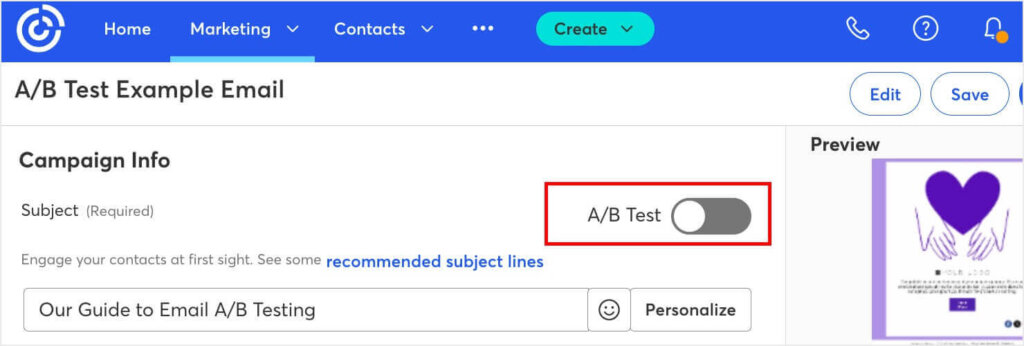
Once you’ve turned on the A/B Test toggle, you’ll see 2 fields to enter 2 versions of your subject line. You can even click Subject line recommendation to get suggestions for possible subject lines to try.

Below the subject line fields, use the slider to adjust the size of your A/B test sample. The number below shows the percentage of recipients that will be left after your A/B test runs.

Finally, use the drop-down menu to select how long you want your test to run.
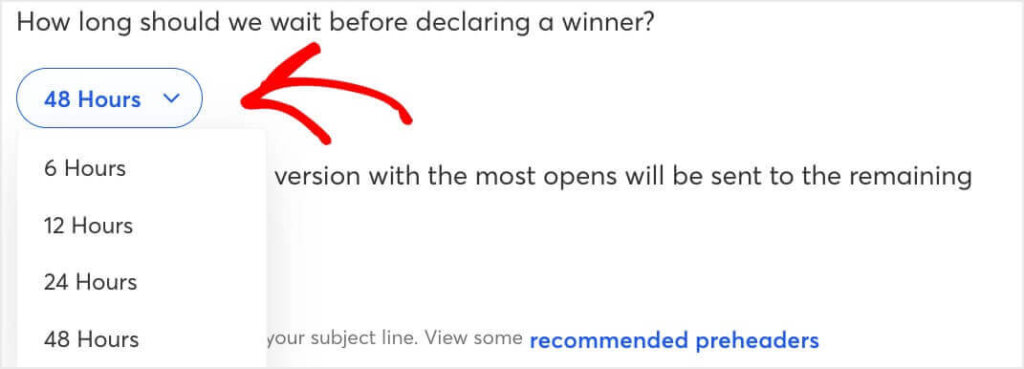
Once you’ve completed the rest of the information on the page, such as From Name and Preheader text, click Send Now. Constant Contact will now run your test, monitor the results, and send the winning variation.
2. Brevo: A/B Test Your Subject Lines or Email Content
Brevo is a great choice if you want an easy-to-use platform that lets you split test elements of your email content, such as headings, images, and CTAs.
When you start the process of creating a campaign, you’ll select whether you want to run a Regular campaign or an A/B Test:
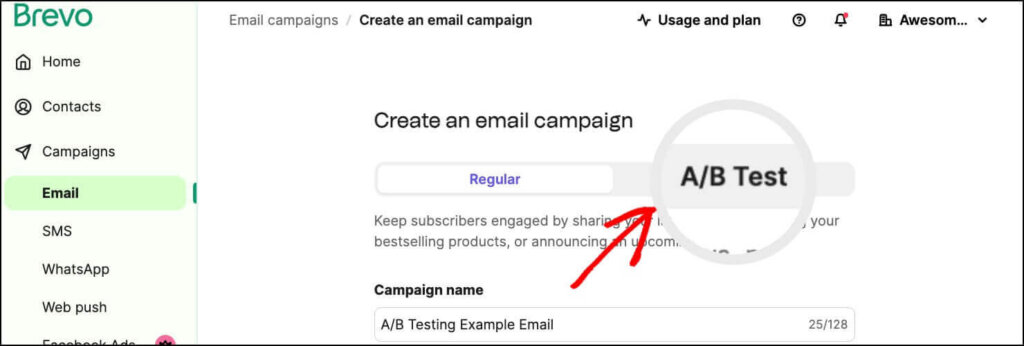
Once you select the A/B Test tab, you can choose to test your Subject Lines or Email Content.
If you choose Subject Lines, you’ll follow steps very similar to Constant Contact.
If you choose Email Content, Brevo will create Design version A and Design version B.
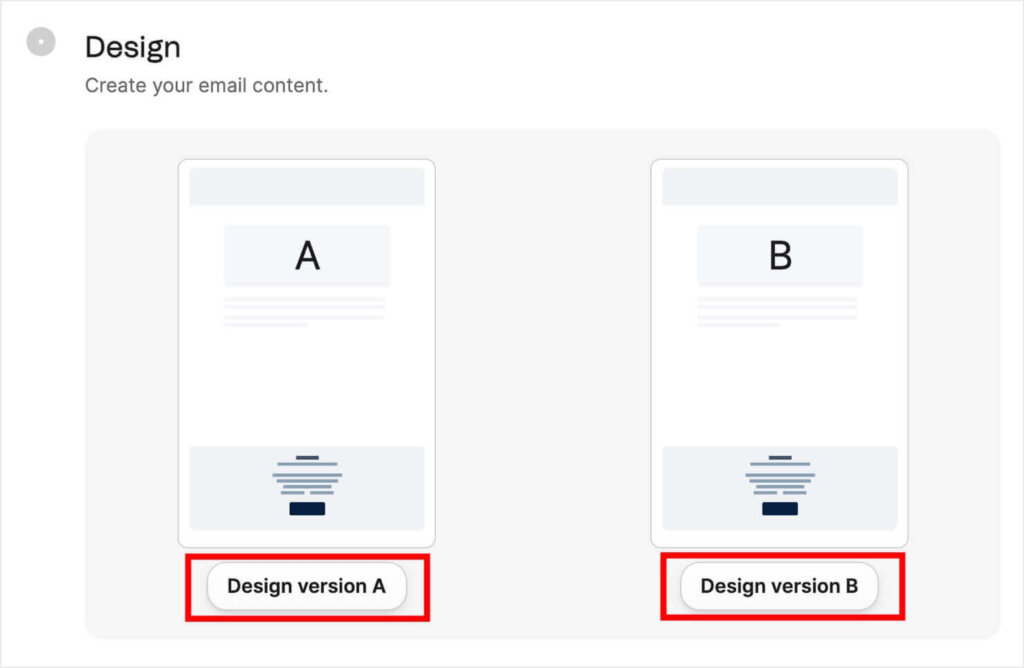
You’ll click on Design version A to create your control email. When you click Design version B, you can select Select a template > Copy Version > Copy from A to start off with an identical version. Then, you can edit a single element for your A/B test.
Just like Constant Contact, you’ll then select your sample size and time period before starting your test.
3. Klaviyo: Full Email Split Testing Functionality
The final email A/B testing tool I’ll cover is Klaviyo. Klaviyo is a more complex email marketing platform with a steeper learning curve, but it also offers more email split testing options than most other tools.
With Klaviyo, you can A/B test:
- Subject Lines
- Email Content (copy, headings, CTAs, etc.)
- Sender Name
- Preview Text
- Send Time
To run an A/B email test in Klaviyo, start by creating an email campaign. Fill out the Campaign Content with your control email’s information. Note that I’ve filled all these fields out as “Version A,” but you would only change 1 of these for any single test.

Click any of the design options on the right to create the content for your control email. Once you’ve finished, click Exit to return to the Campaign Content page.

When you scroll down, you’ll now see a Create A/B test option that you can click.
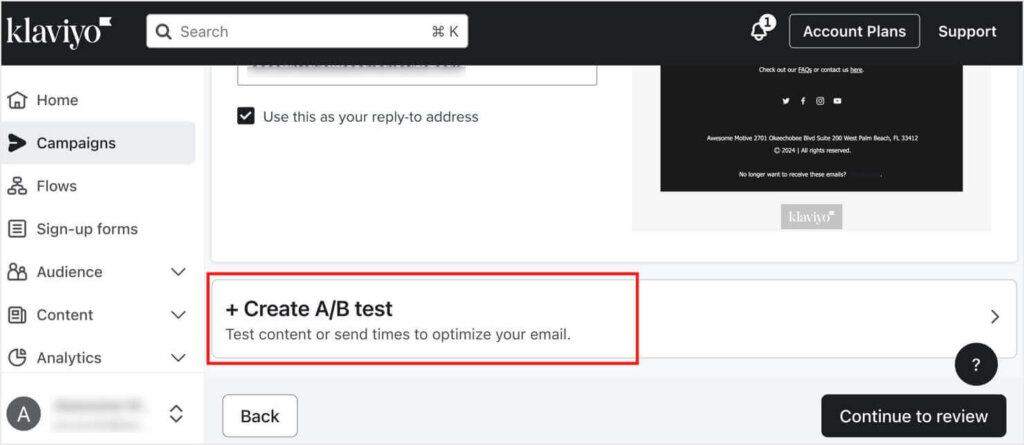
Under Campaign A/B test, you’ll see 2 options: Test content and Test send time.
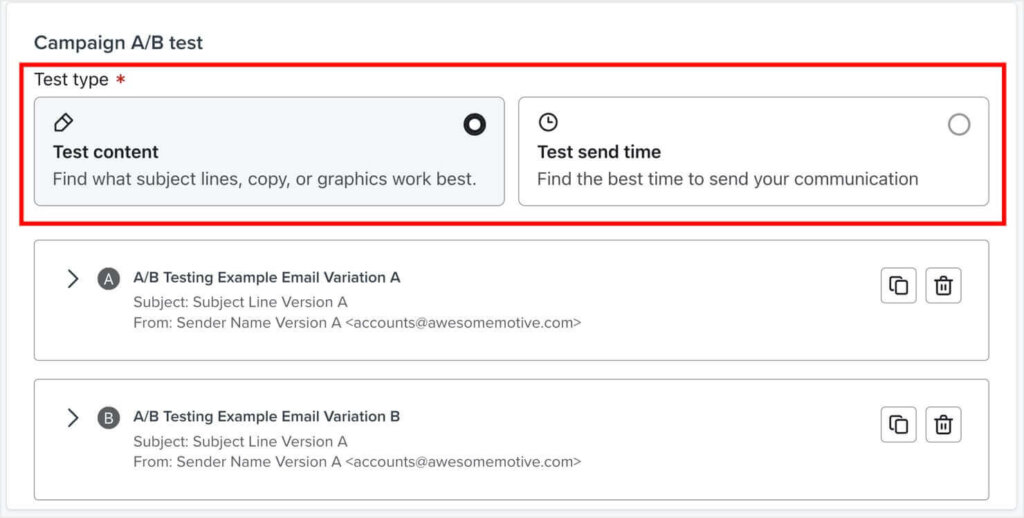
I’m going to focus on testing content, but send-time testing is another powerful email marketing strategy. Learn more about email send-time in my article Decoding the Best Time to Send an Email: Insights From Top Studies.
Click the drop-down arrow beside the B variant to edit the copy of your control email. Edit 1 of the fields to A/B test your subject line, preview text, or sender name. If you want to split test your email content, click Edit email and make your desired change. When you’re done, click Continue to review.
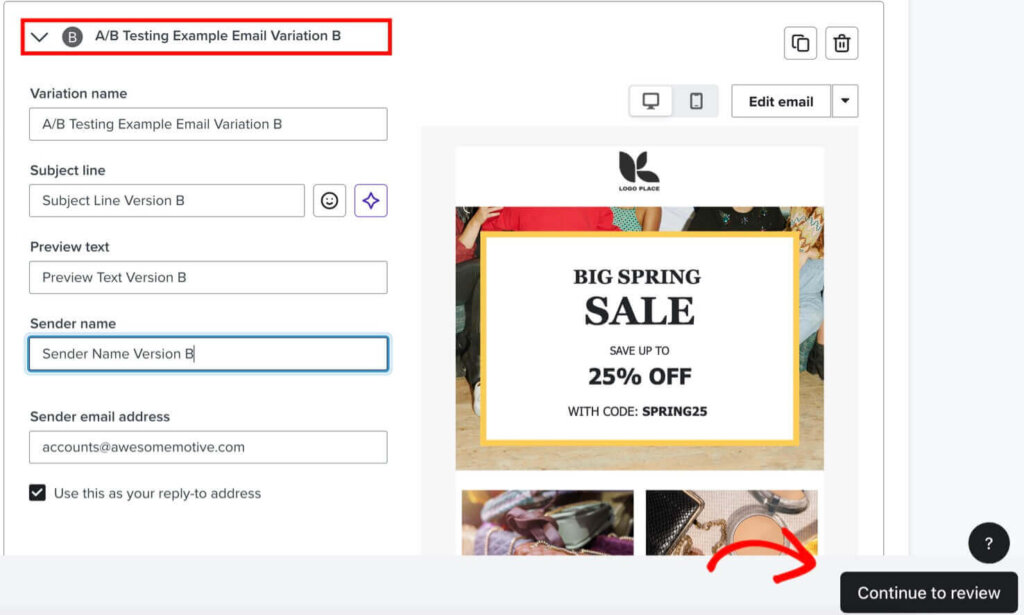
Next, you’ll see the Ready to Send page. Scroll down and click the Edit button beside A/B Testing Settings.
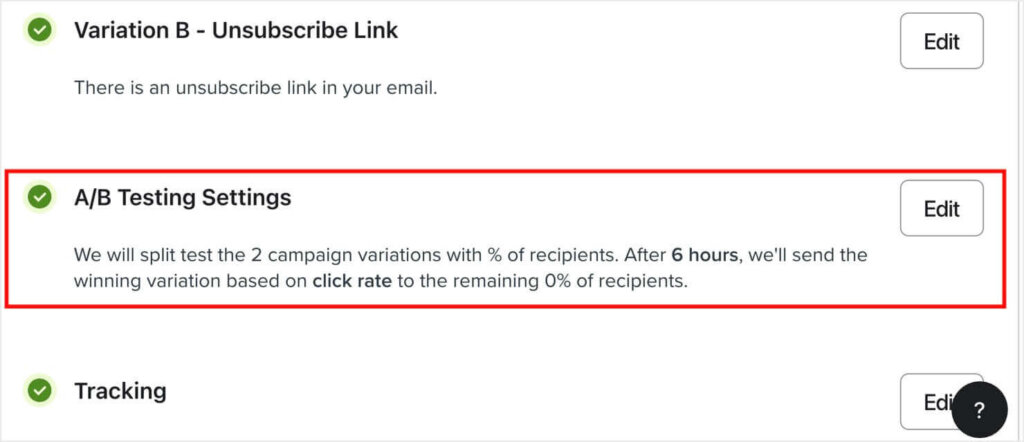
Here, you’ll be able to select the metric you want to measure, your sample test size, and your test duration.

Once you’ve selected your test settings, click Continue to review and then Schedule or Send to start your A/B test.
Grow Your Email List by Split Testing Your Optin Forms
Now that you’ve got a handle on email split testing, there’s one more thing you can do to make your campaigns work even better: improve your email signup forms by using split testing on them, too.
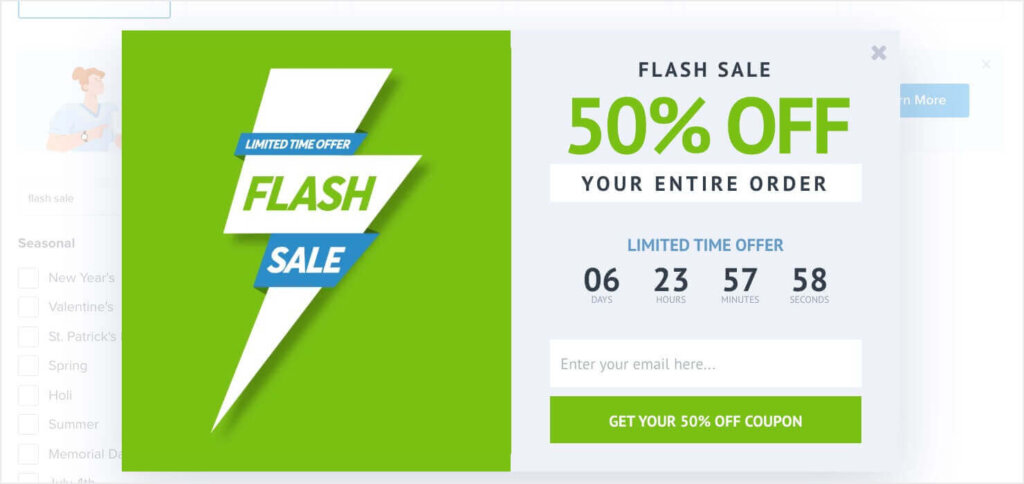
You can accomplish this in just a few clicks with OptinMonster! Our marketing campaign software integrates with the top email marketing services and has built-in split testing to help you create an even more successful email marketing strategy.
You simply create an email signup campaign and then click the Create Split Test icon, which looks like an arrow splitting into 2.

Then, you’ll get a copy of that campaign that you can edit. OptinMonster will show each variant to half of your website visitors, and you’ll get analytics on which version performs the best.
For more details, check out our video guide to split testing an OptinMonster campaign:
There are also written instructions in our documentation. If you want to start split testing your website’s email signup forms, sign up for OptinMonster!
That’s it! Now you know the right way to A/B split test your email campaigns so you can get more opens, clicks, and conversions.
Want to learn even more ways to optimize your email marketing strategy? Check out these resources:
- How to Increase Email Open Rate (With 10 Proven Tips!)
- What Is Email Click-Through Rate (CTR) & How to Improve It
- How to Write the Perfect Welcome Email Series (Nail Your First 5 Emails!)
The first step to successful email marketing is to build an email list full of high-quality, engaged leads. OptinMonster is the best lead-generation software available, helping you convert your website visitors into subscribers and customers.


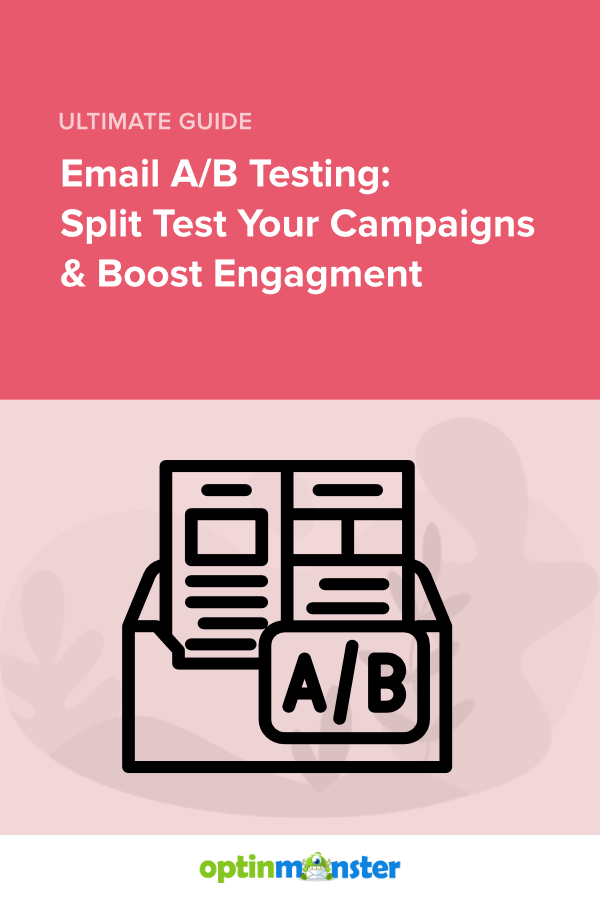








Add a Comment